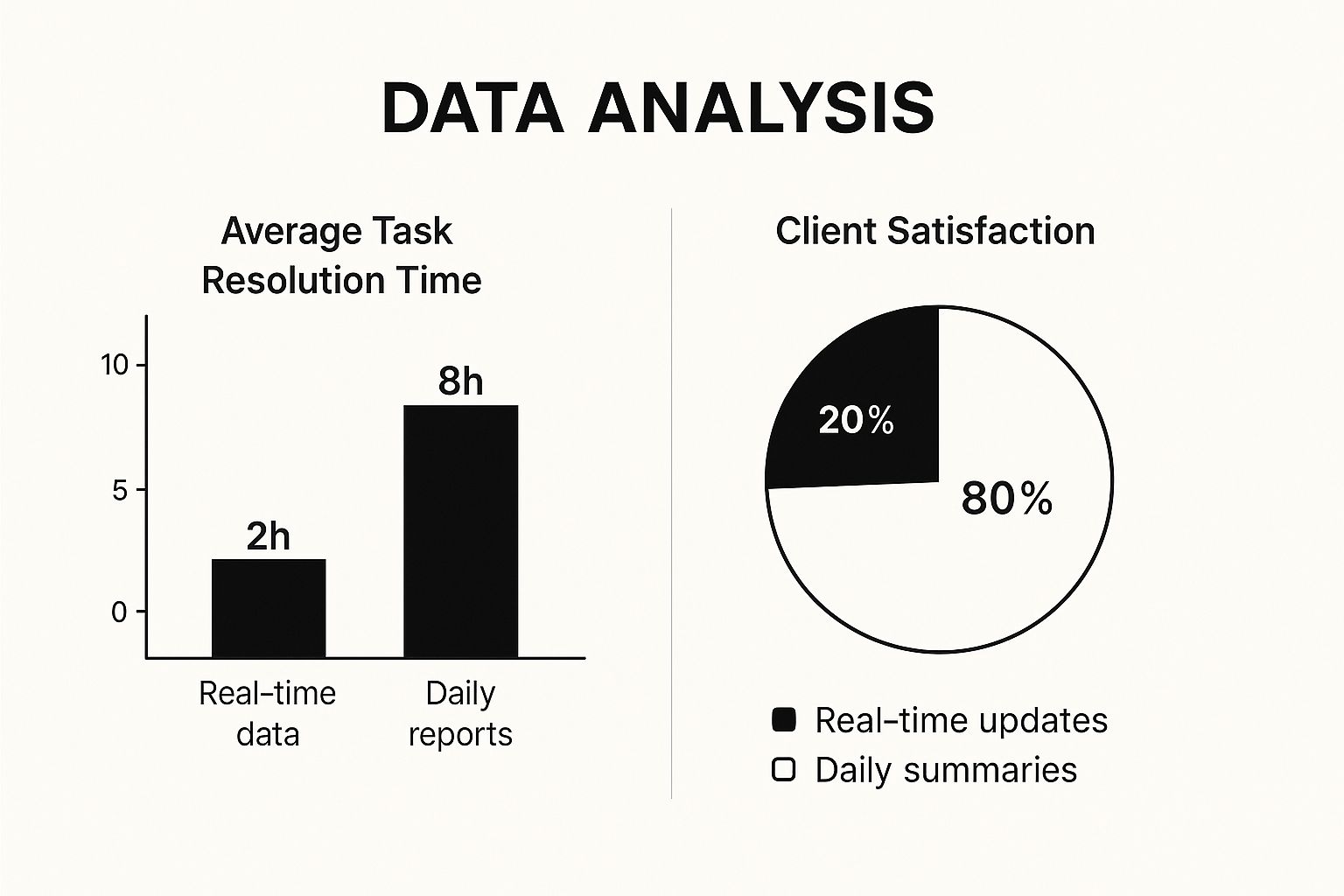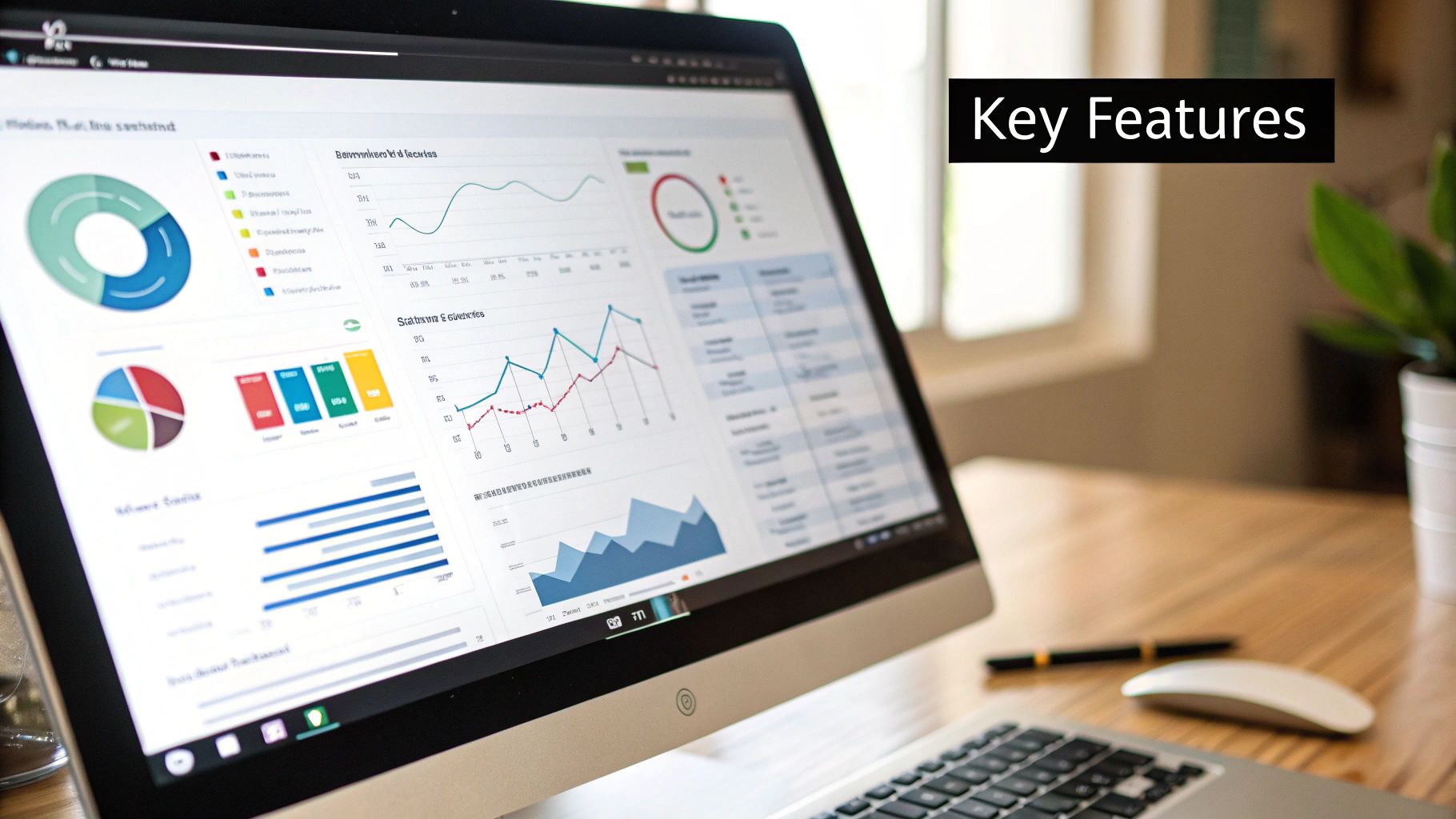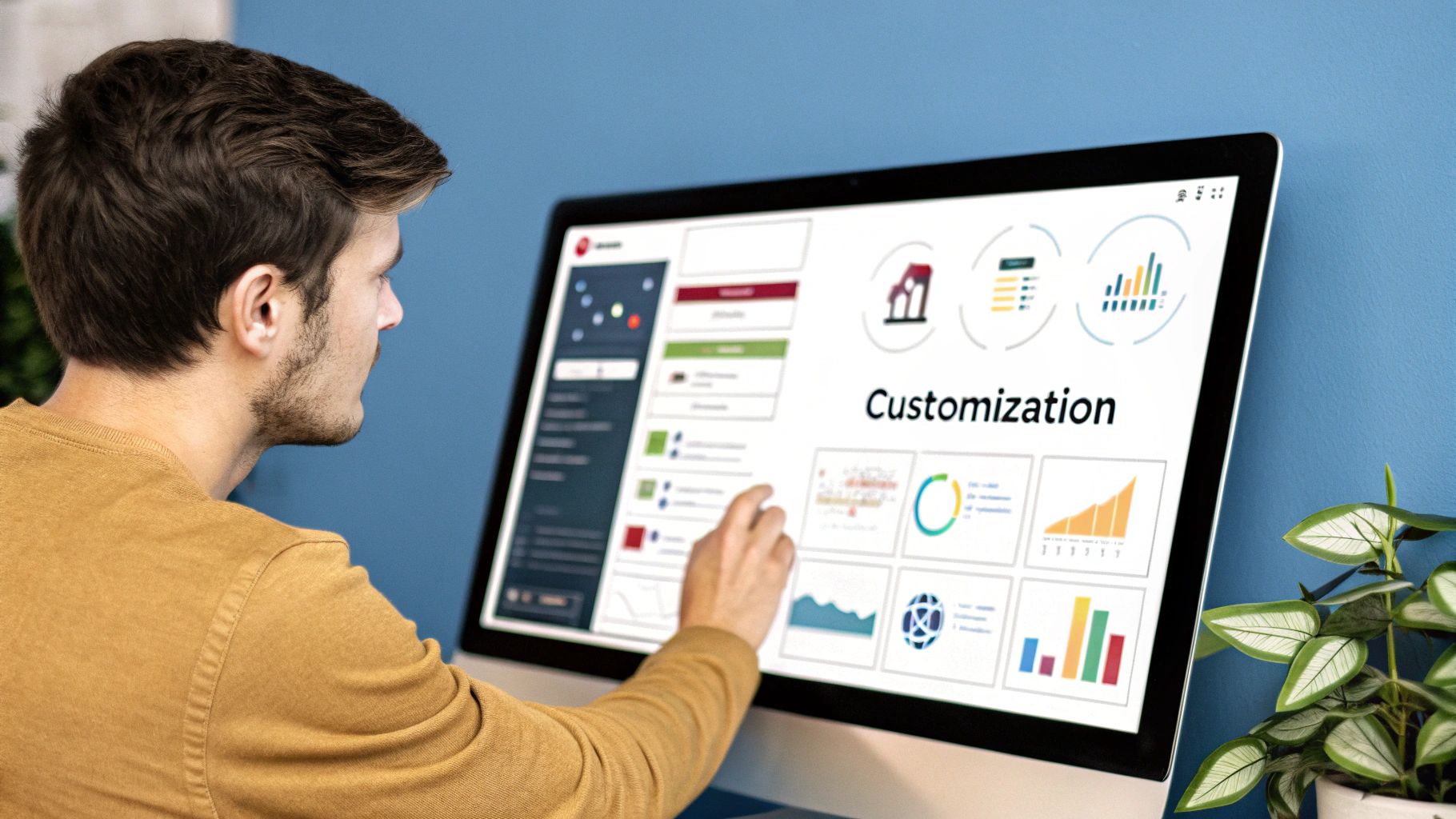Why Modern Agencies Need Powerful SEO Client Dashboards
The days of static monthly SEO reports are a relic of the past. Today's agencies are embracing SEO client dashboards to cultivate stronger client relationships and improve client retention. These dynamic dashboards have grown from simple rank trackers into sophisticated tools that build trust and showcase the value of SEO services. This shift is a direct response to client demand for greater transparency and real-time access to campaign progress.
This demand for transparency is fueled partly by the remarkable growth of the SEO industry. The global SEO market, valued at approximately $82.3 billion in 2023, is projected to reach nearly $143.9 billion by 2030, representing a CAGR of 8.3%. This growth highlights the increasing importance of SEO client dashboards for agencies to effectively manage and demonstrate the value they offer. Explore this topic further
Demonstrating Value and Building Trust
A robust SEO client dashboard offers clients a central hub to track key performance indicators (KPIs), keyword rankings, backlink profiles, and website traffic data. This transparency builds confidence and strengthens the client-agency partnership. Clients gain firsthand insight into how SEO efforts impact their organic search visibility and website performance.
Moreover, these dashboards equip clients with data-driven insights, moving beyond surface-level metrics like rankings alone. Clients can explore meaningful data like click-through rates (CTR), conversion rates, and organic traffic growth to understand the impact of the SEO strategy on their bottom line.
Enhancing Client Communication and Collaboration
Effective communication is essential for any successful client relationship. SEO client dashboards facilitate clear communication by presenting complex data in an easily digestible format. This eliminates the need for long, technical reports that can often confuse clients.
An interactive dashboard also provides a platform for collaborative discussions. Clients can access data, ask informed questions, and engage in productive conversations with their agency, fostering a partnership and shared understanding for better campaign results.
Streamlining Reporting and Saving Time
Manual report creation is a time-consuming and inefficient process. Modern SEO client dashboards automate reporting, freeing up agency time for strategic work. This automation not only saves time but also minimizes the risk of human error, ensuring accuracy and reliability.
The resulting efficiency translates into cost savings for agencies, enabling them to manage more clients effectively. By automating reporting, agencies can dedicate resources to campaign optimization and delivering tangible results, a win-win for both agency and client.
Selecting Metrics That Actually Matter to Your Clients
An effective SEO client dashboard isn't about flooding clients with data; it's about presenting the key performance indicators (KPIs) that align with their unique business goals. This involves understanding what truly drives client satisfaction and focusing on the metrics that resonate with their bottom line. Top agencies understand this and tailor their reporting accordingly.
Aligning Metrics With Client Objectives
Different businesses have different priorities. For a local bakery, the primary goal might be driving phone calls, while an e-commerce store focuses on revenue and average order value. A one-size-fits-all dashboard simply won't work. Customizing the displayed metrics is essential to showcasing the value of your SEO efforts.
For instance, a local business might prioritize local keyword rankings, map pack visibility, and click-to-call conversions. An e-commerce client, on the other hand, would likely track organic revenue, product page rankings, and add-to-cart conversions.
This client-centric approach positions you as a strategic partner, not just an SEO provider. By showcasing metrics directly impacting their revenue, you solidify the value of your services.

The infographic above illustrates the impact of real-time data on task resolution and client satisfaction. Real-time access facilitates significantly faster issue resolution (2 hours vs. 8 hours) and higher client satisfaction (80% vs. 20%). A robust SEO client dashboard is key to providing this level of accessibility.
Telling a Complete Performance Story
Effective dashboards weave together visibility metrics (like rankings and impressions) with engagement metrics (such as click-through rate (CTR) and time-on-site) and conversion data. This creates a holistic view of performance, showing how SEO efforts translate into real business results.
For example, consider the relationship between keyword rankings and CTR. A high ranking doesn't guarantee traffic if the CTR is low. Presenting both metrics side-by-side allows you to identify opportunities to improve title tags and meta descriptions, ultimately driving more qualified traffic.
Statistical analysis further emphasizes the importance of dashboards. Studies show that nearly 99% of searchers don't go beyond the first page of Google search results. This highlights the need to focus on top 10 rankings and monitor CTR, insights readily available through a well-designed SEO client dashboard. Find more detailed statistics here.
Educating Clients Without Overwhelming Them
While demonstrating value is essential, presenting data in a digestible format is equally critical. Avoid overwhelming clients with technical jargon or excessive metrics. Focus on clear, concise information that highlights progress and areas for improvement.
Utilize visualizations like charts and graphs to present complex data in a user-friendly way, making it easier for clients to grasp key trends and understand the impact of your SEO work. Platforms like That's Rank offer customizable dashboards, allowing you to tailor the displayed metrics and their presentation to each client's specific needs.
Clear communication and accessible data foster client trust and confidence in your expertise, ultimately strengthening relationships, increasing satisfaction, and boosting retention rates.
To help agencies tailor their dashboards for maximum relevance, the following table breaks down which metrics should be prioritized based on different client business objectives:
Dashboard Metrics That Drive Client Retention
| Client Goal | Primary Metrics | Secondary Metrics | Custom KPIs |
|---|---|---|---|
| Increase Brand Awareness | Impressions, Reach, Share of Voice | Branded Search Volume, Social Media Mentions | Website Traffic from Branded Campaigns |
| Drive Website Traffic | Organic Traffic, Keyword Rankings, Click-Through Rate (CTR) | Bounce Rate, Pages per Session, Average Session Duration | Traffic from Targeted Referral Sources |
| Generate Leads | Conversion Rate, Form Submissions, Cost per Lead (CPL) | Lead Quality Score, Conversion Path Analysis | Leads from Specific Marketing Channels |
| Boost Sales | Revenue, Transactions, Average Order Value (AOV) | Customer Lifetime Value (CLTV), Return on Ad Spend (ROAS) | Sales of Specific Products/Services |
| Improve Customer Satisfaction | Customer Reviews, Net Promoter Score (NPS), Customer Retention Rate | Support Ticket Volume, Customer Churn Rate | Customer Satisfaction Survey Results |
This table provides a starting point for customizing client dashboards. By focusing on the metrics most relevant to their specific goals, agencies can effectively communicate the value of their SEO services and build stronger client relationships.
Designing SEO Dashboards Clients Actually Want to Use

A visually appealing and easy-to-understand SEO client dashboard is essential for client engagement and satisfaction. Accurate data is the foundation of any good dashboard. However, how that data is presented significantly impacts a client's ability to comprehend and interpret it. This understanding directly influences their perception of your services and the value you deliver.
The Psychology of Effective Dashboard Design
Effective dashboards prioritize clarity and simplicity. They use intuitive design principles to cater to non-technical audiences. This includes using thoughtful color schemes to highlight important data, employing clear and concise labels, and structuring the layout for a logical flow of information.
For example, using contrasting colors for positive and negative trends allows clients to quickly identify areas of strength and weakness. Grouping related metrics together helps clients grasp the connections between different aspects of their SEO performance.
Progressive disclosure is another important design principle. This involves revealing more detailed data upon user interaction. It keeps the dashboard uncluttered while providing access to deeper insights when needed. This approach prevents information overload and keeps the client focused on the most critical data points.
Highlighting Positive Trends and Providing Context
When selecting metrics for your client dashboard, focus on those that align with their business goals. You can learn more about important metrics to consider in your social media strategy. While showcasing positive trends is important, providing context for any fluctuations or challenges is equally crucial.
This means incorporating annotations and explanations directly within the dashboard to explain unexpected changes in performance. A sudden drop in rankings, for instance, might be due to an algorithm update, a technical issue on the website, or increased competition. Providing this context manages client expectations and prevents unnecessary concern.
Highlighting the positive impact of your SEO efforts is key to building client confidence. Showcasing improvements in organic traffic, keyword rankings, and conversions reinforces the value of your services and solidifies your position as a trusted partner.
Real Dashboard Transformations and Client Satisfaction
Transforming a complex, data-heavy dashboard into a user-friendly interface can drastically improve client understanding and satisfaction. Often, these improvements don't require changing the underlying data, but rather how it is visually presented.
Consider a case where a client was overwhelmed by a dashboard crammed with technical SEO metrics. Simplifying the layout, focusing on key KPIs, and adding clear explanations significantly increased the client's engagement and understanding. This led to improved communication, increased trust, and, ultimately, higher client retention.
Essential Design Elements for SEO Client Dashboards
A well-designed dashboard incorporates several key elements:
- Clear Visual Hierarchy: Prioritize the most important information using size, color, and placement.
- Interactive Elements: Allow clients to explore data further through clickable charts and drill-down functionalities.
- Customizable Views: Enable clients to tailor the dashboard to their specific needs and preferences.
- Mobile-Friendly Design: Ensure the dashboard is accessible and easy to navigate on any device.
By incorporating these elements, you create an SEO client dashboard that is not just a reporting tool, but a valuable asset that strengthens client relationships and drives business growth. This approach enhances communication, builds trust, and ultimately contributes to long-term client retention and satisfaction. Using platforms like That's Rank allows for customization and the ability to implement these elements effectively.
To further illustrate the importance of dashboard design, let's examine some research findings:
Introducing the following table which presents research findings on how different design elements and visualization types affect client comprehension of SEO data:
"Dashboard Design Elements: Impact on Client Comprehension"
| Design Element | Impact on Understanding | Client Engagement Score | Implementation Difficulty |
|---|---|---|---|
| Clear Visual Hierarchy | High | 90 | Low |
| Interactive Charts | Medium | 75 | Medium |
| Customizable Views | High | 85 | High |
| Mobile-Friendly Design | Medium | 70 | Medium |
| Contextual Annotations | High | 95 | Low |
| KPI Focus | High | 92 | Low |
As the table shows, elements like clear visual hierarchy, contextual annotations, and a focus on KPIs have a high impact on client understanding and engagement. While some elements, like customizable views, are more difficult to implement, they still offer substantial benefits. By prioritizing these design elements, you can create dashboards that truly empower your clients.
Choosing the Right Technology for Your SEO Client Dashboards
The technology you select for your SEO client dashboards directly impacts their effectiveness and your agency's overall efficiency. Choosing the right platform involves careful consideration of several factors, including your agency's size, technical capabilities, and future scalability needs. Let's explore the practical considerations for building dashboards that deliver real results.
Platform Options and Their Pros and Cons
Several platforms offer solutions for creating SEO client dashboards, each with its own set of advantages and disadvantages. All-in-one SEO platforms frequently include built-in dashboard features, offering a convenient way to manage various SEO aspects within a single interface. However, these platforms may sometimes lack the flexibility and customization options available in dedicated dashboarding tools.
Standalone dashboarding software, like That's Rank, provides more control over data visualization and reporting. These platforms often integrate with numerous data sources, empowering you to create highly customized dashboards tailored to individual client needs. This modular approach lets you choose the optimal tools for each component of your SEO workflow.
For dashboards that clients will actually use, incorporate clear visuals and actionable insights, as discussed in this helpful guide: Social Media Analytics Dashboards. A visually appealing dashboard makes data interpretation easier, which is essential for client engagement.
Scalability and Integration Considerations
As your agency expands, your dashboarding technology must scale accordingly. Selecting a platform that can manage growing data volumes and increasing client numbers is crucial for long-term success. Cloud-based solutions typically offer better scalability than on-premise software.
Seamless integration with your current SEO tools is another vital factor. Ensure the platform you choose connects with your rank tracking software, website analytics, and other data sources to automate data collection and reporting. This integration streamlines your workflow and helps maintain data accuracy.
The development of SEO client dashboards has mirrored the evolution of the SEO field. This growth is driven by the increasing complexity of search, now encompassing mobile, voice, and AI. As of 2025, Google processes approximately 40,000 search queries per second, totaling 3.5 billion searches every day. This enormous data volume makes manual data management practically impossible. Dashboards automate this process, visualizing important data points such as search rankings and backlink profiles. Learn more about current SEO statistics and trends here: Discover more insights about Search Engine Optimization statistics.

Hidden Costs and Implementation Timelines
Beyond the initial software cost, consider potential hidden expenses. Some platforms have additional charges for features like white-labeling, API access, or increased data storage. These added costs can accumulate quickly, so factor them into your budget.
Implementation timelines also differ significantly among platforms. Some solutions offer a straightforward plug-and-play setup, while others require considerable customization and integration effort. Realistically assess your team’s technical skills and available resources when evaluating your options.
Hybrid Solutions and the Power of Customization
Many top agencies now use hybrid approaches, combining the strengths of different tools to build highly effective dashboards. For example, they might use an all-in-one SEO platform for data collection and a separate dashboarding tool for visualization and reporting.
This flexibility lets agencies customize dashboards to the unique requirements of each client. They can select the most relevant metrics, create custom visualizations, and incorporate their agency's branding for a professional, cohesive client experience. By focusing on client needs and utilizing the right technology, agencies can transform dashboards from basic reporting tools into valuable assets that boost client satisfaction and retention.
Automating Your SEO Dashboard Without Losing Control

Manual reporting drains agency resources and limits profitability. For agencies to stay competitive and provide excellent client service, embracing automation is essential. This section explores how successful agencies automate their SEO client dashboards while maintaining data accuracy and valuable insights.
Connecting Disparate Data Sources
A key aspect of automation is connecting various data sources into a single, unified reporting system. This eliminates manual data entry and ensures data consistency across client dashboards. Integrating tools like Google Analytics, Google Search Console, and rank trackers like That's Rank allows for automatic data updates. This reduces manual work and ensures accurate data.
Automated dashboards can also pull data from CRM systems, social media platforms, and other marketing tools. This offers a comprehensive view of client performance. Having this integrated data provides a complete picture of a client's online presence in one accessible location.
Uncovering Automation Opportunities
Many agencies miss significant automation opportunities within their reporting workflows. Automating recurring tasks, such as data collection and report generation, frees up valuable time. This allows for more time to be spent on strategic analysis and client communication.
For example, automating weekly or monthly email reports eliminates the manual process of creating and sending individual reports. This not only saves time but ensures clients receive consistent performance updates. This increased efficiency allows agencies to manage more clients without increasing staff, ultimately boosting profitability.
Maintaining Essential Human Oversight
While automation streamlines processes, human oversight is still critical. Agencies should establish clear checkpoints for human intervention. This is essential for validating data, interpreting trends, and providing strategic recommendations. This balance ensures accuracy and personalized insights.
Data collection and reporting can be automated, but analyzing the data and creating actionable strategies requires human expertise. Automated dashboards provide the raw data; SEO professionals interpret it and translate it into valuable client insights. This partnership between automation and human analysis provides the best results.
Implementation Roadmaps for Different Agencies
Different agencies have varying levels of technical capabilities. Therefore, implementing automation requires a tailored approach. Smaller agencies might begin with basic automation features, like automated report generation. Larger agencies with dedicated development teams can explore more complex integrations and custom solutions. That's Rank offers a range of automation features suitable for agencies of all sizes.
Agencies can implement automation gradually, starting with the most time-consuming tasks. They can then progressively automate other aspects of their reporting workflow. This phased approach minimizes disruption and allows for a smooth transition. Automating SEO client dashboards improves efficiency, enhances client satisfaction, and unlocks greater profitability. The key is balancing automation and human oversight, ensuring data accuracy while leveraging automation to drive client success.
Turning Dashboard Reviews Into Client Retention Sessions
Even the most detailed SEO client dashboard won't help if it doesn't translate into real value for your clients. This goes beyond simply presenting data. It's about fostering understanding and building a solid partnership. Successful agencies recognize this, transforming dashboard reviews from routine reports into strategic conversations that strengthen client relationships and unlock growth opportunities.
Frameworks for Guiding Client Discussions
A structured approach to dashboard reviews ensures you address all key points and maintain focus on achieving client goals. Begin by reviewing the overall performance summary, highlighting significant wins and tackling any obstacles.
Then, delve into specific metrics, directly linking them to the client's business objectives. For instance, if the client aims to increase online leads, demonstrate the growth in organic traffic to relevant landing pages and the resulting rise in form submissions. This clearly connects your SEO efforts to their desired outcomes. Using a platform like That's Rank streamlines this process, enabling you to tailor dashboards to showcase the most important KPIs for each client.
Questioning Techniques to Connect Metrics to Goals
Asking effective questions transforms a passive data overview into an active exchange. Instead of just presenting numbers, encourage client involvement with open-ended questions that relate dashboard metrics to their business goals.
- "How does this rise in organic traffic fit into your broader marketing strategy?"
- "What potential do you see based on the higher keyword rankings for these important terms?"
- "How can we use this information to refine our SEO strategy and drive even better results?"
These questions empower clients to think strategically about their SEO performance and actively participate in the discussion, fostering a sense of ownership and collaboration.
Presentation Strategies for Maintaining Engagement
Even complex SEO concepts can be communicated in an engaging and accessible manner. Visuals like charts and graphs make data more digestible, helping clients grasp trends and pinpoint areas for improvement. Avoid technical jargon. Instead, use clear, concise language that emphasizes the impact of the data.
Crafting a narrative around the data is another impactful technique. For example, explain how improvements in site speed resulted in a lower bounce rate and increased conversions. This creates a compelling story that resonates with the client and showcases the value you deliver.
Real Conversation Examples and Meeting Templates
Real-world examples and meeting templates further enhance your dashboard review process. Sharing case studies demonstrating how similar clients benefited from data-driven insights can build confidence and illustrate the potential for growth.
A well-structured meeting template ensures consistency and efficiency. It provides a framework for addressing all crucial topics, from analyzing key metrics to discussing next steps and outlining future goals. This keeps the meeting focused and productive.
Building Client Confidence and Expanding Engagements
By turning dashboard reviews into strategic dialogues, you build client trust and reinforce your role as a valuable partner. This increased confidence often translates into expanded projects as clients recognize the potential for further growth and entrust you with more of their marketing initiatives.
Transforming data into actionable strategies is essential for client retention. By showcasing the value of your SEO services and actively involving clients in the strategic decision-making process, you cultivate strong relationships that drive long-term success. This client-focused approach not only boosts retention, it benefits your business overall.
The Future of SEO Client Dashboards: Staying Ahead of Trends
The SEO world is in constant flux, and client dashboards must adapt. New technologies, particularly in artificial intelligence (AI) and predictive analytics, are changing how agencies showcase their SEO value. These advancements are transforming dashboards from simple reporting tools into strategic advisors.
AI-Powered Insights and Predictive Analytics
Imagine a dashboard that not only displays current performance but also anticipates future outcomes. Machine learning algorithms are making this possible. By examining historical data and current trends, AI can project potential shifts in rankings, traffic, and conversions. This foresight allows agencies to proactively modify strategies and optimize campaigns for maximum effect.
For instance, AI can pinpoint emerging keywords and recommend content optimization strategies before competitors even notice them. This proactive approach can drastically improve a client's organic search visibility and attract more qualified visitors to their website. That's Rank leads the way in integrating AI into its platform, equipping agencies with these powerful capabilities.
From Reporting Tools to Strategic Advisors
The next generation of SEO client dashboards goes beyond simply presenting data; they offer actionable advice. AI can analyze complex data sets and identify areas for improvement, ranging from technical SEO issues to content optimization opportunities.
This shift transforms the dashboard from a passive reporting tool into an active strategic advisor. Instead of merely showing clients what happened, it guides them on what to do next. This enables agencies to provide more strategic guidance and strengthens their value to clients.
Experimental Features and Practical Value
While some emerging technologies hold great potential, not all deliver on their initial promise. Features like voice search optimization and SERP feature tracking are becoming increasingly vital. However, others, such as real-time competitor analysis, may not offer the practical value initially anticipated.
Agencies should carefully assess new features and prioritize those that truly benefit their clients. Concentrating on practical applications, such as identifying relevant keywords and optimizing content, yields tangible results. Integrating these valuable insights into a platform like That's Rank simplifies the process for both agencies and clients.
A Roadmap for Next-Generation Dashboard Adoption
Integrating advanced dashboard features should not disrupt existing client relationships or overwhelm your team. A phased approach is essential. Begin by identifying the most beneficial features for your clients. Then, gradually incorporate these features into your workflows. Platforms like That's Rank provide a variety of features to support this gradual integration.
Train your team on how to use the new features effectively. This ensures everyone is comfortable with the technology and can communicate its value to clients. By strategically embracing these advancements, agencies can improve client services, generate better results, and stay ahead of the curve.